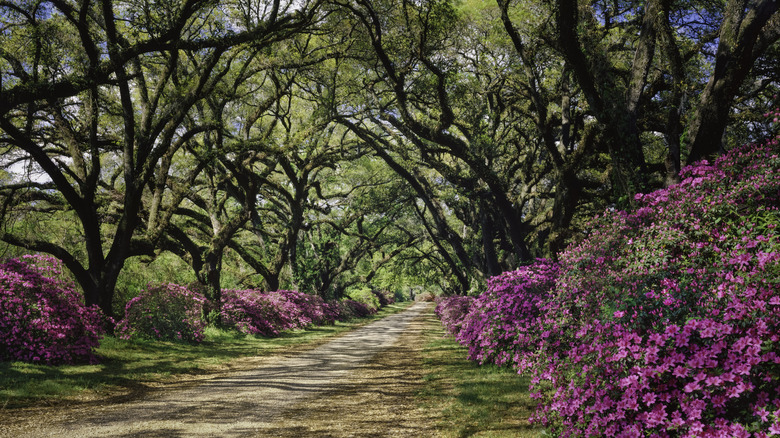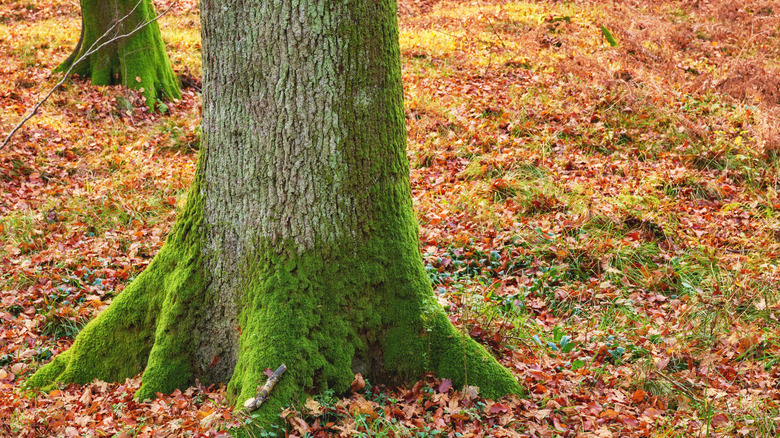Revitalize Your Landscape By Transplanting Your Oak Tree
We may receive a commission on purchases made from links.
There's nothing worse than expecting a towering shade tree and ending up with an oak tree that's droopy, dying, or just can't grow to its full potential. If you're regretting your location choice for your oak tree (Quercus spp.), transplanting it can bring new life to your landscape. Perhaps you made some of the common mistakes when planting a tree, such as not realizing what size it would grow to — there are over 450 varieties of oak trees, after all! Or maybe you skipped the important step of looking up to check for power lines when planting your tree. If your oak tree doesn't have enough space to grow or was improperly planted in the wrong-size hole or with the wrong soil, you may be better off transplanting it so you can start all over again.
First, determine if transplanting is really necessary, as you risk damaging the tree's root system each time you move it. It's best to move trees only if they have trunks less than 2 inches wide, leaving the larger trees to professionals. However, a sub-optimal location or other projects — such as adding onto your house, building a shed, or other hardscaping projects — may mean the tree has to move. Slow-growing oaks are sturdy performers in the landscape, providing shade and homes for area wildlife. With careful planning, relocating your oak tree can ensure it continues to thrive while complementing your evolving landscape.
How to transplant your oak tree
When transplanting a tree, it's important to plan ahead. To prepare your tree for transplanting, focus on stimulating root growth within the area that will become its root ball. Research shows that light root pruning encourages trees to produce new roots. Several months before the move, use a sturdy spade or trencher to sever roots beyond the future root ball, cutting the tree's connection to them. This method not only fosters new root development but also helps reduce transplant shock when the tree is relocated. In addition, make sure to thoroughly water the ground three or four days before the planned transplant. The right prep work will make your transplant a success.
Finally, choose a location that's suited to your variety of oak, with at least six hours of direct sunlight and a soil pH between 6.0 and 7.0.. If you don't know your soil's pH, you can measure the pH of your soil at home with this simple method. Then, dig a hole that's as deep as your root ball and twice as wide. Carefully remove your oak tree and wrap it in burlap, such as Burloptuous Multipurpose Burlap Fabric. Transport it to its new home, filling in with topsoil as needed. Water thoroughly, providing 5 to 7 gallons weekly, and consider using fertilizer, such as Jobe's Slow-Release Tree and Shrub Fertilizer Spikes. These steps will help your oak tree survive transplanting.
Mistakes to avoid when transplanting your oak tree
While transplanting an oak tree may seem straightforward, a few common missteps can lead to long-term struggles for your tree's health and growth. First of all, make sure you don't dig too big of a hole for your tree. If your tree is too deep in the hole, it can rot the bark and the roots. This can even kill your tree after a few years. You want to be able to see the root collar, a flared portion at the base of the trunk just before the roots go into the ground. If you can't, your hole is too deep. While this may seem like a simple problem to fix — adding more dirt to the hole seems easy enough! — the loose dirt you add can still be compacted by the weight of your tree and root ball, causing it to fall further later. If you dig too deeply, you may be better off digging another, shallower hole nearby rather than trying to fix the one you've already dug.
Next, check that you don't mulch too close to the tree trunk. It's the best practice to leave 4 to 6 inches between your mulch and the tree trunk, making sure not to cover the root collar. In addition, oaks do best when lightly mulched, meaning less than 2 inches of mulch in a year. By following these tips, you'll ensure your oak tree has the proper conditions to thrive.


